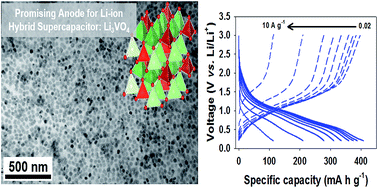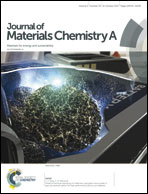Rational design of Li3VO4@carbon core–shell nanoparticles as Li-ion hybrid supercapacitor anode materials†
Abstract
A Li-ion hybrid supercapacitor (Li-HSC) delivering high energy within seconds (excellent rate performance) with stable cycle life is one of the most highly attractive energy storage devices. However, the limited anode materials for Li-HSC systems lead to stagnation and restrict the development of high-performance Li-HSCs. To tackle this problem, a facile synthetic route to Li3VO4@carbon core–shell nanoparticles (Li3VO4@C NPs), a promising high-power anode for Li-HSCs, is reported. The synthesized Li3VO4@C NPs show a high specific capacity of ∼400 mA h g−1 at the current density of 0.02 A g−1 in the potential range from 0.2 to 3.0 V (vs. Li/Li+), with rapid charge/discharge characteristics (∼110 mA h g−1 at 10 A g−1). By various electrochemical analyses, it was demonstrated that the excellent electrochemical properties of Li3VO4@C NPs stem from their improved pseudocapacitive behavior and their low internal resistance, which are mainly due to the synergistic effects of (i) a well-designed electrode morphology achieved by nano-engineering and (ii) the structural merits of a core–shell architecture. In addition, the Li-HSC using the Li3VO4@C NP anode and activated carbon (AC) cathode provides ∼190 W h kg−1 energy and ∼18 500 W kg−1 power density, with long-term cycle stability in the potential range from 0.0 to 4.3 V.



 Please wait while we load your content...
Please wait while we load your content...